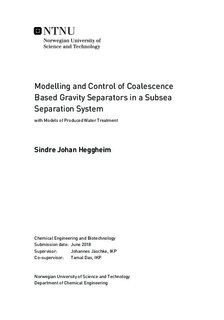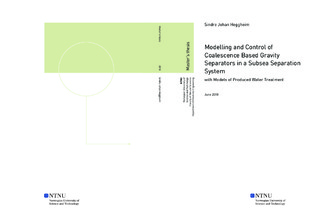| dc.description.abstract | Subsea separation of well fluids is a way to reduce the cost of topside processing, and to simplify and reduce the export of products. Subsea separation consist of bulk separators and purifiers, to separate the multi-phase well stream and to get as clean phases as possible. Models and simulations of the subsea process is needed to optimize the process, and to assure that the purity restriction on the produced water to be injected, is held.
The aim of this work has been to develop dynamic models of the separators in the bulk separation of the well stream. The developed models was two coalescence driven gravity separators with main focus on oil-water separation. The oil product of the first stage gravity separator (three phase) was fed to the second stage gravity separator (two phase). The models of the bulk separators were combined with existing models of inline de-oiling hydrocyclones and compact flotation units, which are used in produced water treatment. The combined system was simulated and controlled with proportional integral (PI) controllers.
The steady state gravity separators were implemented and solved in MATLAB with CasADi. The models uses Stokes' terminal velocity adjusted by the water cut and coalescence of droplets with 10 different sizes in the range of 150 µm to 300 µm in diameter. The steady state is solved for wanted pressure, liquid level and water level. Interior point optimizer (IPOPT), with slacks on the overconstrained equality constraints, was used to solve the steady state. The dynamic models, with product flows as system inputs, were solved and simulated with ODE15s-solver in Simulink.
The gravity separator models showed reasonable steady state solutions and dynamic behavior with the guessed model parameters. The model would benefit from better tuned model parameters from measured data. The simulation of the combined bulk and water treatment showed that the water treatment was able to control the purity of the produced water and that a restructuring and tuning would improve the control even further. | |

